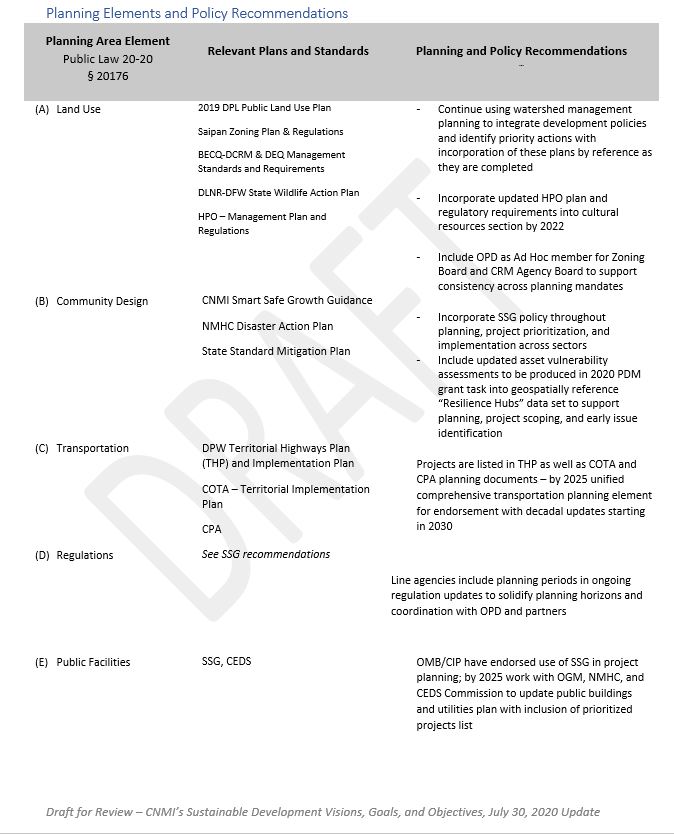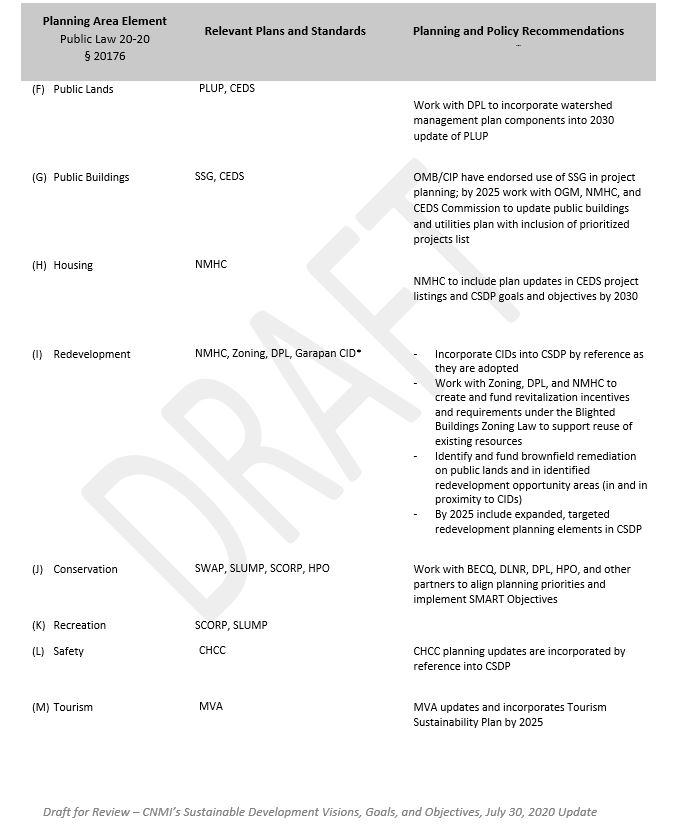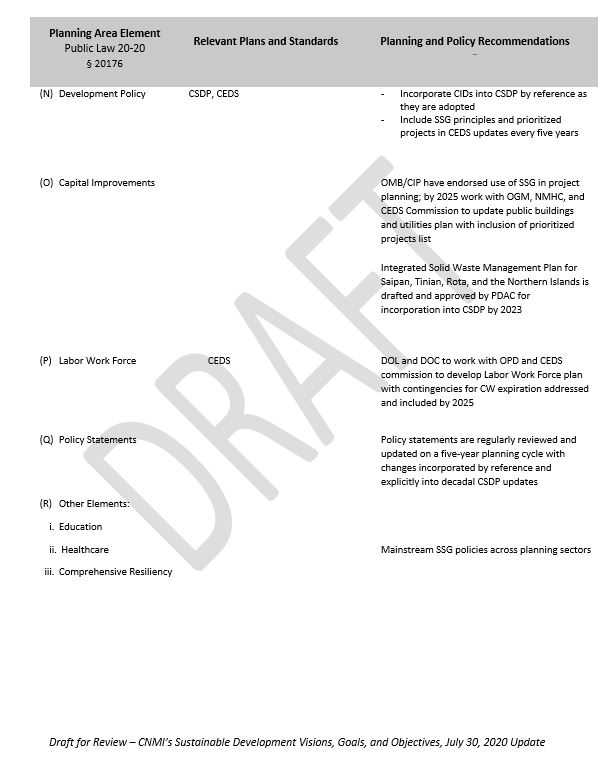This document reflects the draft values, visions, goals, and objectives to support sustainable development in CNMI across agencies and sectors. They have been developed through review of existing plans and guidance as well as over twenty interagency planning meetings and scoping meetings with community stakeholders of Saipan, Tinian, and Rota.
These guiding values, vision statements, goals, and supporting objectives are currently in draft form. Additional feedback is being sought to ensure that they (i) align with existing agency and CNMI-wide visions and mandates; (ii) are realistic and achievable; and (iii) support overarching community aspirations for the CNMI. Please email planning@opd.gov.mp to share your feedback including additional edits or suggestions for inclusion in the next round of goal and objective updates by August 25, 2020 so these visions, goals, and objectives can be included in the CNMI’s draft Comprehensive Sustainable Development Plan for further review and comment. Your input is much appreciated as we work to envision a resilient and sustainable CNMI.
Guiding Values
The guiding values or core values are those characteristics that we commit to as individuals and as an organization so we develop a culture that achieves our mission. The guiding values are a way that we deliver on our mission and execute our vision – they describe or define the culture. These are broad, subjective concepts that are intended to provide a sense of direction for planning efforts.

The “values” shown here are a result of initial survey efforts. Larger words reflect more than one submission in the of that term. Please visit this survey if you would like to rank your top three value “themes” or suggest other values for consideration in future surveys. These terms will be used to help develop policies for planning themes in the revised draft plan.
Sustainability Visioning
The following “vision” statements were created in coordination with the Planning and Development Advisory Council’s Natural Resources, Built Environment, and Socio-Economic/Disaster Risk Reduction Taskforces. They build from and connect to “functional plans” and cross-cutting sustainability priorities as informed by the “planning elements” identified for inclusion in the Comprehensive Sustainable Development Plan by Public Law 20-20. These vision statements help us chart our course to the future we hope to achieve by 2030. Ongoing interagency and inter-sectoral adaptive management planning efforts will help the CNMI leverage our resources to work towards the visions and supporting goals and objectives outlined here in the Comprehensive Sustainable Development Plan. Special area and resource management plans and functional plans for infrastructure development combined with development standards will reinforce the “Sustainable Development Goals” and “Planning Policy Crosswalks” outlined further here. Together these efforts will enable the CNMI’s public, private, non-profit sectors and our stakeholders at large to achieve progress towards shared sustainable development objectives.
To submit additional feedback, you can contact us at planning@opd.gov.mp, or call (670) 488-1221 and your comments will be included in our next revision.
Planning Elements Visions
Development Policy to Mainstream Smart, Safe Growth in Public Facilities, Public Buildings, and Capital Improvement Projects
Vision: Ensure application of Smart, Safe Growth principles across planning elements to support development and conservation strategies to improve communities, strengthen economies, protect the natural environment, and improve resilience and recoverability of the built environment. (SSG Mainstreaming Vision)
Public Land Use
Vision: Provide for the efficient and effective services in the management, use, disposition and development of public lands for the economic and social betterment of individuals of Northern Marianas Descent and to implement the Strategic Public Land Use Plan to promote cultural and economic growth for the benefit of our present and future generations. (2019 PLUP)
Transportation, Community Design, and Design Regulations
Vision: Transportation infrastructure in CNMI is built & maintained to provide inviting, accessible, safe, convenient, and comfortable routes for walking, bicycling, and public transportation that encourage increased use of these modes of transportation, enable convenient travel as part of daily activities, improve the public welfare by addressing a wide array of health and environmental problems, and meet the needs of all users of the streets, including children, older adults, and people with disabilities. (Complete Streets Working Group)
Economy and Work Force
Vision: CNMI will leverage its assets of cultural and natural resources to grow a diverse economy grounded in a sustainable workforce and resiliency in our built environment to assure a safe, healthy, and vibrant community for all. (2019 CEDS)
Housing and Redevelopment
Vision: Support affordable, fair, equal opportunity of efficient and responsive delivery of housing, mortgage and community development programs to increase ownership of safe, sanitary, and affordable homes and promote economic independence, self-sufficiency, and upward mobility to the people of the Commonwealth and address the growing and future needs and economic viability. (NMHC)
Conservation – Natural Resources
Vision: To sustainably conserve and use natural resources to support the development needs of today without compromising the needs of future generations. (NR Taskforce)
Conservation – Cultural Resources
Vision: Through survey, research, education, and stewardship historic preservation management planning conserves and enhances important historic, archaeological, architectural and cultural resources on public and private lands throughout the Commonwealth improving the quality of life for all residents of the CNMI. (HPO 2015 Vision, updated)
Recreation
Vision: To provide world-class outdoor recreation experiences with high-quality facilities and diverse activities and access opportunities for CNMI residents and visitors. (2020 SCORP)
Tourism and the Visitor Industry
Vision: The Marianas are as one of the most preferred destinations to experience happiness, excursions, harmony, strength, and celebration in the global tourism market, offering choice and diversity for visitors and residents alike. Through integrated resource planning and management efforts our islands support a modern, sustainable, and successful tourism industry that provides jobs, a good tax base, and diverse customer base that provides a healthy level of profit for businesses, supported by convenient, affordable transportation that promotes inter-island travel, and opportunities to enhance, preserve, and share CNMI’s culture with the outside world. The tourism and visitor industry are well-integrated with all aspects of community planning and development to result in less vulnerability to external events and a level of visitor arrivals that can support a good quality of life for the community, without adversely impacting the beautiful natural environment. (2020 MVA Tourism Plan (in development)
Public Safety and Disaster Risk Reduction
Vision: Maintain and enhance community safety in the Commonwealth and work across sectors to identify and manage risks to ensure populations have adequate access to evacuation routes, food, water, and subsequent medical services during and after a disaster and that preparations are in place that make CNMI a safe place to weather a storm. (SE-DRR Taskforce)
Health Systems
Vision: Improving CNMI health and well-being through excellence and innovation in services. (2015 CHCC Strategic Plan Plan)
The Commonwealth Healthcare Corporation’s (CHCC) 2015-2020 Strategic Plan aims to improve the standard of services to the people of the CNMI as well as overall health and wellbeing of its populace. To achieve this goal, CHCC has been working to implement eight (8) operating strategies which include organizational and facilities objectives. Outcomes include obtaining full accreditation from the Centers for Medicare and Medicaid (CMS) for the hospital(recently surveyed in May 2019), public health, behavioral health, as well as decrease the incidence of the top six (6) major causes of death and debilitation in the CNMI: cancer, diabetes, hypertension/heart disease, teen pregnancy, HIV/STI, and substance abuse. These goals are aimed to address community health system needs and support achievement and maintenance of numerous targets of Sustainable Development Goal 3 – Good Health and Well Being.
Education Systems
Vision: CNMI will provide high quality, affordable and accessible educational programs and services to drive economic growth and the social and cultural vitality of the Commonwealth. (Education Partners)
Partnerships
Vision: OPD and Planning Partners will Support Coordination for Comprehensive Planning (§ 20177)
Sustainable Development Goals – Planning Across PDAC Taskforces
The following list represents the proposed “right-sized” sustainable development goals (SDG) and supporting objectives developed by the Office of Planning and Development (OPD), the Planning and Development Advisory Council (PDAC), and the Planning Taskforces on Socio-Economics / Disaster Risk Reduction, the Built Environment, and the Natural Environment. These dialogs were initiated by the endorsement of the Sustainable Development Goals as a planning framework by the PDAC over several meetings in 2018-2019 and Taskforce planning meetings held in February and June, 2020. The ten-year SDG statements are intentionally ambitious – the aim of this planning exercise is to implement realistic objectives that help move the Commonwealth of the Northern Mariana Islands (CNMI) closer to its vision of sustainability for each of these sectors.
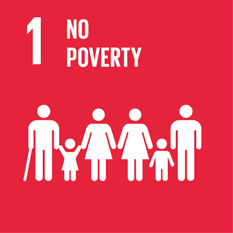
SDG #1 - End poverty in all its forms
- By 2024, OPD, PDAC, and the Socio-Economics (SE) Taskforce will work together with Commerce, OMB, and OGM to formalize a capital improvements plan and project prioritization proposal for inclusion in 2025 CSDP and CEDS planning updates
- By 2025, Department of Commerce will work with the SE Taskforce to establish a baseline for “living wages” for localized poverty assessment to track progress towards poverty reduction and support of basic quality of life for all people in the CNMI;
- By 2025, CUC will work with OPD/PDAC to include prioritized wastewater management community projects in capital improvement funding requests; and
- By 2025, the Socio-Economic Taskforce will work with the Department of Labor to (i) improve access to paid sick leave for all participating in the CNMI workforce, with the aim to ensure that at least 75% of full-time CNMI workers have paid sick leave and (ii) reduce the proportion of community members with no health insurance from 32% in 2010 to 25%.
- By 2023, CUC, BECQ-DEQ, DPW, and DPL will integrate geospatial utilities data to identify areas of wastewater services to support utility, capital improvement program, and land use planning updates, and by 2025, CUC will work with OPD/PDAC to include prioritized wastewater management community projects in capital improvement funding requests to achieve 100% inside flush toilets with compliant wastewater management by 2030; and
- By 2023, CUC, BECQ-DEQ, DPW, and DPL will integrate geospatial utility data to identify areas of water services to support utility, capital improvement programs, and land use planning updates;
- By 2025, CUC will work with OPD/PDAC to include prioritized water management community projects in capital improvement funding requests to achieve 100% 24-hr plateable water services by 2030, supported by disaster risk reducing retrofits and economical mitigation measures.
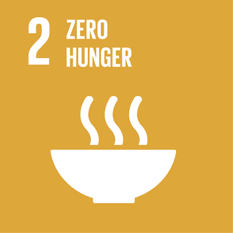
SDG #2 - End hunger, achieve food security and improved nutrition, and promote sustainable localized agriculture
- Ensure a more affordable supply of healthy local foods and reduce accessibility to unhealthy food by: (i) working with CNMI Forestry and partners to launch community gardens in every village and senatorial district by 2025; (ii) working with CDA, NMC-CREES, and partners to expand agroforestry programs and demonstration projects with the goal of implementing at least one demonstration project or workshop annually between 2022 – 2025 to provide tools and knowledge to increase GDP from agriculture to over 2.5% by 2030; and (iii) supporting CHCC’s inclusion of assessment of local food choices in periodic non-communicable disease surveys to provide data to further track these efforts by 2025.
- Support home gardening and agroforestry initiatives in partnership with CDA and NMC-CREES with through development of formal outreach plan and prioritized actions by 2022 for inclusion in future planning updates; include designated community gardens in DPL’s 2030 Public Land Use Plan update;
- By 2025, CHCC in partnership with the CNMI Nutrition Council will work to improve access to strengthen local farmer livelihoods, increase food security, and improve nutrition through expansion of the Biba program to support a public food procurement policy which favors food produced locally and meets or exceeds nutrition standards;
- By 2025, CHCC in partnership with PSS and DCCA will establish nutrition guidelines and standards for meals, snacks, and beverages served to children on a regular basis by institutions and businesses in the CNMI, including all public facilities which serve meals to children, all daycares, and all schools to improve health, food related knowledge, and food consumption patterns of children, their families, and staff; and
- By 2025, CHCC, CNMI Nutrition Council, and the Nutrition Assistance Program will develop policies and incentives to ensure that 20% of stores registered with the Nutrition Assistance Program adopt the Healthy Stores Initiative administered jointly by the CHCC and CNMI Nutrition Council.
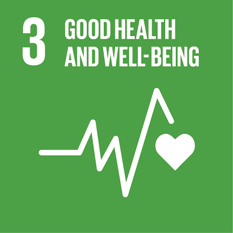
SDG #3 - Ensure healthy lives and promote well-being for all people at all ages
- Reduce mortality and morbidity and maintain the WHO goal of stable incidence rates of diabetes cases annually with a focus on preventing chronic disease through active transportation, increased availability of healthy locally-sourced food, and healthy community design and planning. CHCC will work with OPD, the PDAC, and SE Planning Taskforce, and NCD Taskforce to integrate healthy community planning across all sectors by 2025;
- By 2025 CHCC, PSS, NMC-CREES, and supporting partners will implement plans to increase access to healthy, local, affordable food choices in all CNMI schools so that, by 2030, at least one “locally-sourced lunch” option can be made available to meet once-a-week serving demand for all students in primary and secondary schools and NMC;
- By 2025, the CNMI Department of Finance, Division of Procurement and Supply, in partnership with Socio-Economic Taskforce including CHCC and the CNMI Nutrition Council will develop policies to ensure that all public procurement from restaurants and caterers are from those businesses which meet or exceed BIBA Initiative standards which supports nutrition standards to promote healthy lives and well-being; and
- By 2030, CHCC leads interagency health and wellness planning efforts to ensure continued metric monitoring and progress towards achieving WHO goals and SDG Targets including:d
- SDG 3.1.1 – By 2030, continue to maintain a maternal mortality ratio of less than 1 per 100,000 live births;
- SDG 3.1.2 – By 2030, continue to maintain a proportion of births attended by a skilled health professional at no less than 99%;
- SDG 3.2.1 – By 2030, continue to maintain deaths of newborns and children under 5 years of age to less than 1 per 1,000 live births;
- SDG 3.2.2 – By 2030, reduce neonatal mortality rate to 1 per 1,000 live births;
- SDG 3.3.1 – By 2030, reduce the number of new HIV infections per 1,000 uninfected population, by sex, age and key populations to 0;
- SDG 3.3.2 – a. 2030, reduce the incidence of tuberculosis per 100,000 from 90.4 to 75; b. % of patient population who are tested using Xpert MTB/RIF as the initial diagnostic test with a target of 95% of culture positive TB cases who receive a complete drug susceptibility examination within 60 days of MTB confirmation; and c. % of culture positive TB cases who receive a complete drug susceptibility examination within 60 days of MTB confirmation with a target of 95%;
- SDG 3.3.3 – By 2030, maintain a malaria incidence rate of 0 per 1,000;
- SDG 3.3.4 – By 2030, reduce the Hepatitis B incidence rate per 1,000 to 40;
- SDG 3.3.5 – By 2030, maintain a number of zero people requiring interventions against neglected tropical diseases;
- SDG 3.4.1 – By 2030, reduce the mortality rate per 100,000 between the ages of 30 and 70 years from cardiovascular diseases, cancer, diabetes, or chronic respiratory diseases to 14,110 or less;
- SDG 3.4.2 – By 2030, reduce the suicide mortality rate per 100,000 from 15.4 to 14 or less and maintain or increase suicide prevention outreach services
- SDG 3.4.2.a – By 2030, reduce the percentage of high school students who actually attempted suicide in the past year by 10% of the rate reported in 2017;
- SDG 3.4.3 – By 2030, show no increase in diabetes prevalence among adults;
- SDG 3.4.4 – By 2030, show no increase in hypertension prevalence among adults;
- SDG 3.5.1 – By 2030, the CNMI will have evidence-based treatment interventions across the continuum of care for substance use disorders. Partnership between the CHCC, the Substance Abuse, Addictions, and Rehabilitation (SAAR) Program under the Office of the Governor, Drug Court Program under the CNMI Superior Court, and other treatment and support facilities and organizations will work toward achievement of this goal;
- SDG 3.5.2 – By 2030, the CNMI will aim for a 15% reduction in harmful use of alcohol in each of the following areas: underage drinking, binge drinking, and drinking and driving. Partnership between the CHCC, the Department of Commerce, and the Department of Public Safety will support work toward achievement of these goals
- SDG 3.6.1 – By 2030, reduce the death rate due to road traffic injuries per 100,000 to 4 or less annually;
- 3.7.2 – By 2030, reduce the adolescent birth rate per 1,000 (ages 10 to 19) to 6.
- 3.8.2 – By 2030, reduce household expenditure on health to 15% of total income;
- 3.8.3 – By 2030, increase the proportion of adults who have visited a medical provider for a general physical exam in the last year to 45%;
- 3.8.4 – By 2030, decrease the prevalence of dental caries (tooth decay) in school aged children by 20%;
- 3.8.5 – By 2030, increase the percentage of adults who have received a dental exam in the past year to 32%;
- 3.9.1 – By 2030, continue to maintain a mortality rate attributed to household and ambient air pollution of fewer than 1 per 100,000;
- 3.9.2 – By 2030, continue to maintain a mortality rate attributed to unsafe ware, unsafe sanitation, and lack of hygiene of fewer than 1 per 100,000;
- 3.9.3 – By 2030, continue to maintain a mortality rate attributed to unintentional poisoning of fewer than 1 per 100,000;
- 3.a.1 – By 2030, reduce age-standardized prevalence of current tobacco use among persons aged 15 years or older to 20% or less;
- 3.c.1 – By 2030, data is collected and regularly updated to assess the density of physicians per 1,000, nursing and midwifery personnel per 1,000, dentistry personnel per 1,000, and pharmaceutical personnel per 1,000.
- 3.d.1 – Percentage of attributes of 13 core capacities that have been attained at a specific point in time and planning efforts are implemented to ensure that CHCC meets or exceeds 70% percentage value based on 13 core capacities. The 13 core capacities are: (1) National legislation, policy and financing; (2) Coordination and National Focal Point communications; (3) Surveillance; (4) Response; (5) Preparedness; (6) Risk communication; (7) Human resources; (8) Laboratory; (9) Points of entry; (10) Zoonotic events; (11) Food safety; (12) Chemical events; and (13) Radionuclear emergencies
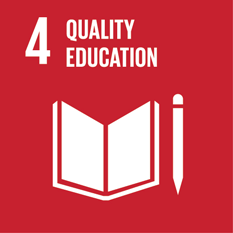
SDG #4 - Ensure inclusive and equitable quality education and promote lifelong learning opportunities for all
- By 2022, NMC and PSS will re-evaluate and update their MOU to support student readiness and incorporates program priorities into an integrated education plan for lifelong learning opportunities in CNMI by 2025;
- By 2022, the CNMI Youth Senate and other youth groups such as Inafa maolek manhoben Marianas will join regular Taskforce meetings and support ongoing school curricula development;
- By 2025, NMC and PSS planning updates will detail efforts to support the goal to decrease the percentage of incoming NMC freshmen in need of placement in remedial classes by 10% or more by 2030; and
- By 2025, CSDP update has revised objectives for ensuring cultural values and traditional knowledge are included in school curricula and lifelong learning programs that include opportunities to build sustainability skills.
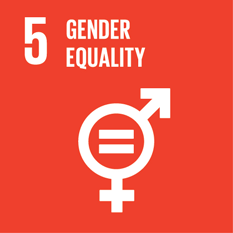
SDG #5 - Achieve gender equality to empower all people
- By 2022, OPD will work with the Women’s Affairs Office, PDAC, and planning taskforce partners as well as active community groups to establish a community meeting schedule for refining objectives and developing a gender equality and empowerment planning component for inclusion in 2025 CSDP planning update.
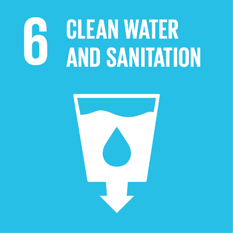
SDG #6 – Ensure availability and sustainable management of safe and environmentally compliant water and sanitation for all
- By 2022 CUC will work with BECQ-DEQ and CHCC to assess healthprotective safe drinking water standards and include resulting recommendations in the CUC Water Master Plan by 2022 and subsequent CEDS update by 2025;
- By 2023, CUC, BECQ-DEQ, DPW, and DPL will integrate geospatial utilities data to identify areas of water and wastewater services to support utility, capital improvement program, and land use planning updates to achieve 100% inside flush toilets with compliant wastewater management and 100% 24-hr palatable water services by 2030, supported by disaster risk reducing development and retrofits and economical mitigation measures;
- By 2025, CUC will update and implement priority action items for their service areas plan for non-sewer areas, including consideration of actions to address changing environmental conditions to the wastewater management system;
- Led by the Bureau of Environmental and Coastal Quality, watershed management and restoration efforts will result in: (i) Reduction of saltwater intrusion into Saipan’s freshwater lens by 20% by 2025 (as measured by reduced chloride levels in CUC managed assets); and (ii) Reduction of stormwater runoff by maintaining and increasing wetland, green infrastructure, and stormwater management processes including aquifer recharge by achieving a 50% reduction in water impairment ratings for the coastal waters of Saipan, Tinian, and Rota by 2030;
- Led by DPW and supported by the Built Environment Taskforce, (i) by 2023, DPW will implement updated guidelines for the MS4 stormwater permit to ensure environmentally compliant and sustainable management of nonpoint source pollution conveyed by stormwater infrastructure; (ii) by 2025 DPW will draft a stormwater management plan with interagency support that considers “Smart, Safe Growth” principles including projected changes to precipitation patterns and sea level rise to further enable these efforts
- By 2022, CUC’s Master Plan will be updated to include details that address what steps are necessary and sufficient to reduce the salinity of the water in Saipan to the secondary standard of 250 ppm by 2030, including consideration of future precipitation patterns and potential impacts to the water system;
- Led by DPW and supported by the Built Environment Taskforce, (i) by 2023 DPW will implement updated guidelines for the MS4 stormwater permit to ensure environmentally compliant and sustainable management of nonpoint source pollution conveyed by stormwater infrastructure; and (ii) by 2025 DPW will draft a stormwater management plan with interagency support that considers “Smart, Safe Growth” principles including projected changes to precipitation patterns and sea level rise to further enable these efforts;
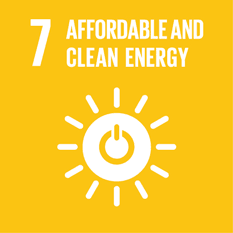
SDG #7 – Ensure access to affordable, reliable, sustainable and modern energy for all
- By 2022, CUC will endorse a Comprehensive Energy Plan detailing the steps necessary and sufficient to diversify the CNMI’s energy portfolio and make progress towards renewable energy standards;
- By 2025, the CUC-led and OPD, DPW, and CBMA supported Energy Feasibility Assessment will be completed to inform and update public laws and pursue grants to facilitate incorporation of renewable energy into the grid and incentivize distributed deployment;
- By 2025, CUC will have identified pilot projects to support a phased Comprehensive Energy Plan and a plan is in place to address existing and future community needs; and
- By 2030, CUC and planning partners have implemented an integrated utility-scale photovoltaic system to meet 20% of the respective peak demand for Saipan, Tinian, Rota and the Northern Islands.
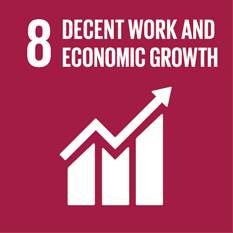
SDG #8 – Promote inclusive and sustainable economic growth supported by expanded educational and employment opportunities for all
- By 2023, Commerce, Finance, OMB, and OPD, with support of the PDAC and planning partners, will work to draft guiding policies to address poverty reduction;
- By 2025, Commerce, OPD, PDAC, and partners will work to ensure that the CEDS update includes an unemployment and poverty reduction planning component to identify priority projects that support economic diversification and growth; and
- By 2026 MVA Tourism Plan will be updated to address sustainability recommendations, track progress, and assess successes and opportunities of tourism contributions to CNMI economy with the goal of achieving at least 65% GDP contribution over a ten-year average between 2020 and 2030;
- By 2030 the CNMI will develop a plan to support the needs of the coming generation of Manamko’ with the Aging Center and Municipal partners.
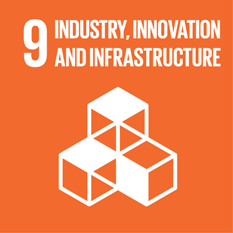
SDG #9 – Build resilient infrastructure, promote inclusive and sustainable industrialization, and foster innovation
- By 2025, OPD ensures robust, integrated transportation planning is formalized and integrated into CNMI’s CSDP. This effort includes implementing and measuring progress towards objectives where: (i) By 2022, CUC installs LED lighting at pilot area sites and works with DPW and CHCC to support safe road lighting deployment planning elements; (ii) By 2023 CHCC’s Walkability Plan is incorporated into DPW and COTA plans to support implementation of “safe and accessible” roads for active, and accessible transportation; and (iii) By 2024, DPW, CPA, COTA, CPA, and CHCC, with support of other relevant partners, will endorse a comprehensive transportation planning vision, with supporting objectives, and goals for inclusion of a robust transportation planning element for the whole of CNMI in the 2025 CSDP update led by OPD;
- By 2022, OPD obtains complete coverage maps for cell and broadband coverage and works with Commerce to update HIES survey data specific to internet accessibility to support planning efforts that include subsidy programs or community connection hubs to ensuring that all residents of Saipan, Tinian, and Rota have in-home access to the internet through broadband or wireless connection by 2030;
- By 2022, DPW works with OPD and Transportation Planning partners including COTA and CPA as well as CHCC to update the 20-year Highway Master Plan to include walkability and accessibility recommendations identified by this group in 2020 scoping discussions; and
- Promote sustainable watershed and stormwater management planning through data-driven collaboration where (i) DPW with support of OPD, the Hazard Mitigation Office, and the Mayors Offices map all primary and secondary road infrastructure by 2023 to support the development of flood hazard mitigation and stormwater management planning guidance with support from DEQ by 2025; and (ii) DPW works with DEQ and partners to revise the 2005 Stormwater Management Plan for CNMI by 2025 to further support integration of land based pollution management across planning sectors and projects.
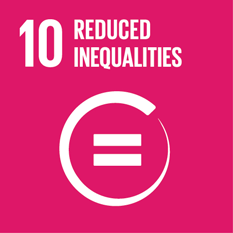
SDG #10 – Eliminate inequality and support diversity, equity, inclusion, and justice
- By 2023, Commerce, Finance, OMB, and OPD with support of the PDAC and planning partners, will work to draft guiding policies that address poverty reduction;
- By 2025, Commerce, OPD, PDAC, and partners will work to ensure that the CEDS update includes unemployment and poverty reduction planning component to identify priority projects to support economic diversification, equality, and growth including underserved populations, LGBTQIA+ community members, and returning veterans;
- By 2030 the CNMI will develop a plan to support the needs of the coming generation of Manamko' with the Aging Center and Municipal partners.

SDG #11 – Make cities and human settlements inclusive, safe, resilient, and sustainable
- By 2025, CNMI’s State Comprehensive Outdoor Recreation Plan (SCORP) will be updated to include the conservation status of cultural, natural, and mixed-designation sites with area- and resource-specific plans and data collection, including the number of cultural and historical sites that are recorded and inventoried, with at least 50% annual preservation of newly discovered cultural heritage resources; public annual expenditures remain constant; private preservation data is collected; and
- By 2025, SCORP, PLUP, Zoning, and Watershed Plans are aligned to identify publicly managed “open space” areas and ADA accessible areas with goal of at least 85% open space or pervious surface maintained in each sub-watershed.
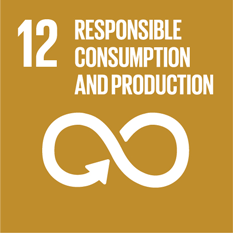
SDG #12 – Ensure sustainable consumption and production patterns
- By 2022, DEQ with support from DPW and OPD will obtain centralized data and statistics on hazardous waste and CNMI-wide import / export stream for integrated waste management plan to be finalized by 2023 and included in 2025 CDSP update;
- By 2025, OPD and DEQ will support DPW in the development and incorporation of the integrated waste management plan with recycling stream tracking and reporting protocols in place to support future updates and the PDAC, Legislature, and CNMI Governor adopt the plan update;
- By 2025, OPD, the CEDS Committee, and the Socio-Economic Planning Taskforce will include data collection and consideration of programs to support exportation of local produce in economic planning and development to enhance economic growth and sustainability;
- By 2030, 50% of the recyclable waste stream will be diverted from CNMI’s landfill or RCRA-compliant waste management facilities on Saipan, Tinian, Rota, and the Northern Islands with diverted waste composted, reused, or sold to support sustainable waste management systems.
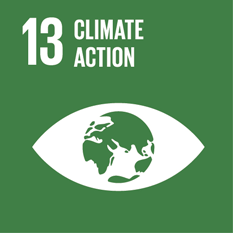
SDG #13 – Take urgent action to combat climate change and its impacts
- By 2023, the Office of Planning and Development (OPD) has launched a “Smart Safe Growth” (SSG) toolkit on the OPD website to support integration of climate impacts and adaptation opportunities into early planning and project scoping activities with at least three SSG trainings held for CNMI agencies and stakeholders by 2025;
- By 2025, resource management specialists across sectors will work with the Hazard Mitigation program and OPD to update and integrate climate data and sector-specific planning recommendations across sectors;
- By 2025, PSS and partners will work to establish and expand Marianas-wide educational programs or institutions and resources, including materials translated into Chamorro and Carolinian languages with place-appropriate images to enable continued engagement and deep, solutions-focused education in natural resources studies in CNMI;
- By 2030, OPD and the PDAC have incorporated cross-cutting climate action planning needs across resource management sectors for the next full CSDP update;
- By 2030, reduce risks from climate impacts for communities within flood zones and on low-lying islands through flood zone map updates, implementation of education and outreach programs, application of current building codes, and permitting incentives;
- By 2030, CNMI has constructed a “Marine Center” that includes holistic education and outreach components that include Marianas specific climate change information that supports K-12 and college level curriculum components as well as community and tourism information sharing and events
- By 2030, PSS has expanded climate considerations which are integrated public school science and social studies curriculum through place-based and service-learning opportunities that include Chamorro and Carolinian language and cultural studies.
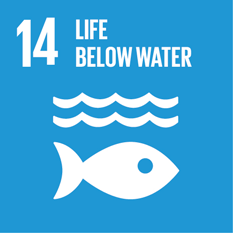
SDG #14 – Conserve and sustainably use the oceans, seas, and marine resources for sustainable development
- By 2025, Coral Restoration Management Team comprised of DCRM and DFW support implementation of and regular updates to the Coral Reef Restoration Management Plan;
- By 2025, the Division of Fish and Wildlife (DFW) will work with partners to promote a sustainable fishing industry throughout the Marianas by creating a CNMI fisheries management program that includes expanded in-house capacity to conduct resource assessments of fish and invertebrates in CNMI to support sustainable fisheries management through improved monitoring, data analysis, regulation assessment, and enforcement while factoring in fishing industry, development, and tourism needs;
- By 2025, the Division of Fish and Wildlife, supported by resource management partners at BECQ and others, will conduct and complete recruitment studies from marine protected areas (MPAs) to document benefits and to establish sustainable management program;
- Led by DFW and supported by resource management partners at BECQ and DPL, a Fish and Coral Restoration Program will be established by 2025 to create a fish and coral conservation action plan to enhance resource biodiversity and reef health;
- DFW will work with partners to conduct life history studies on targeted food fish in the CNMI to determine growth rates, longevity, reproduction, and mortality. The information generated will be used for sustainable management of fisheries by 2025;
- The Department of Lands & Natural Resources (DLNR) – DFW will work on improving boating infrastructure by 2025 to minimize environmental impacts on nearshore resources and to allow for safe boating access;
- DLNR/DFW will work with regional partners to improve fishery data collection efforts in the CNMI and generate information needed to sustainably manage fishery resources by 2025;
- DLNR/DFW continues to work with state and federal partners in conducting nearshore fish, invertebrate and benthic assessments throughout the CNMI to better document resource abundance and diversity. Information generated from this work will be used to sustainably manage nearshore fishery resources;
- By 2025, DLNR/DFW will work with partners to improve enforcement capacity by evaluating existing fishery regulations and policies to determine validity within current concerns. Revisions will be made to ensure that these regulations meet current and future management needs; and
- DLNR/DFW will work with partners to develop sustainable fishing access programs such as Fish Aggregating Devices (FADs) to promote alternative fishing opportunities that help reduce fishing impacts in nearshore waters.
- By 2030 Marine Center construction complete, resulting in inter-agency marine studies that support the creation of jobs, integrate with school curriculum and outreach programs with sustainable revenue being generated through guided tours, book sales, special events, and/or other dedicated funding mechanisms;
- By 2030, there are interagency programs to support active management of prioritized in-water resources and management areas reflected in the CSDP update, and at least 50% of marine resources are being effectively managed through site-specific management plans
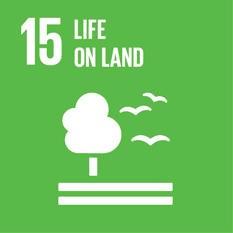
SDG #15 – Protect, restore, and promote sustainable use of terrestrial ecosystems, sustainably manage forests, and preserve and halt degradation of biodiversity and resources of particular concern in the CNMI
- By 2025 the Department of Lands and Natural Resources will update the State Wildlife Action Plan and continue periodic updates every ten years with data and input included from natural resource management partners at BECQ as appropriate;
- CNMI Forestry will work with management partners to monitor, maintain, and restore at least 10% land cover to native and endemic forest communities by 2030;
- CNMI’s Department of Land and Natural Resources and Bureau of Environmental and Coastal Quality work together to ensure no net loss of limestone forest, coral reefs, sea grass, and wetlands to protect ecosystems and biodiversity and support habitat connectivity;
- By 2030 CNMI continues progress in maintaining the amount of man-made wildfires is reduced by 50% in area from 2020 numbers;
- By 2022, BECQ develops a Wildfire Management Plan that addresses planning, response and mitigation of wildfires to support efforts to reduce human induced wildfire, reduce fire risk, and restore fire-impacted sites to support healthy watersheds and communities; and by 2025 the amount of man-made wildfires is reduced by 50% in area;
- By 2021, BECQ-DCRM will reconvene the Wetlands Working Group including DLNR, DPL, OPD, and members of the Natural Resources Planning Taskforce to collaborate develop, adopt, and begin implementation of a Comprehensive Wetlands Management Plan by 2025; and
- Led by the Bureau of Environmental and Coastal Quality, watershed management and restoration efforts will result in:
- Reduction of saltwater intrusion into Saipan’s freshwater lens by 20% by 2025 as measured by reduced chloride levels in CUC managed assets;
- Reduction of stormwater runoff by maintaining and increasing wetland, green infrastructure, and stormwater management processes including aquifer recharge by achieving a 50% reduction in water impairment ratings for coastal waters of Saipan, Tinian, and Rota by 2030.
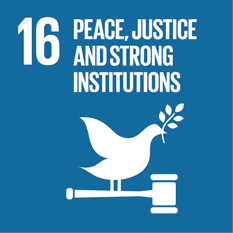
SDG #16 – Promote peaceful and inclusive societies for sustainable development, provide access to justice for all and build effective, accountable and inclusive institutions at all levels
- By 2023, DPS and OPD, with support of the PDAC, CHCC, and other planning partners, will work to draft guiding policies that support reduction of physical, psychological, and sexual violence in the CNMI; and
- By 2025, OPD, PDAC, and partners will work with DPS and the Judiciary to ensure that the CSDP update includes violence reduction policy recommendations and identifies priority projects to support this goal, with a target of 10% reduction in violent crimes by 2030.
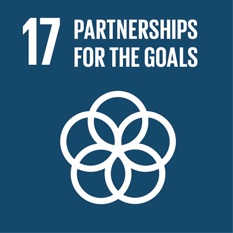
SDG #17 – Strengthen the means of implementation and support partnerships for sustainable development
- By the end of 2020, OPD, Commerce, and PDAC, and other planning partners will endorse the sustainable development planning component and Smart, Safe Growth integration recommendations to identify priority projects to support economic diversification and growth for inclusion in the 2021-2025 CEDS update and future plan revisions.
- By 2023 Commerce, Finance, OMB, and OPD with support of the PDAC and planning partners, will work to draft guiding policies that address poverty reduction and track changes in annual GDP;
- By 2024, Commerce HIES surveys will provide data on internet access and use these data points to address remaining deployment gaps, if any, in the 2025 CEDS update with support from OPD, PDAC, and Planning Partners;
- By 2030, led by OPD and facilitated through partnerships with planning agencies and other stakeholders, scheduled planning updates detailed further in Appendix I of this CSDP will be completed and incorporated into a 2030+ planning update;
- The 2030 CSDP update will reflect growth in community engagement as indicators of enhanced partnerships by at least doubling the number of public comments received in the 2019-2020 CSDP draft and comment period;
- The 2030 CSDP and corresponding 2030 CEDS update will include a detailed assessment of GDP expenditures, imports, and exports trends, and other economic data identified by the PDAC and SE/DRR Planning Taskforce.
Natural Resources (NR) Taskforce
Taskforce Vision: Preserving CNMI’s natural capital while balancing economic growth and equitable opportunities for all
The Natural Resources (NR) Taskforce focuses on SDGs 13, 14, and 15. Draft updated goal statements and objectives are outlined here.
Together, the Sustainable Development Goals and their objectives aim to support communities, people, the economy, and the environment. These goals and management areas are in many ways interconnected, as the image below attempts to help visualize. Sustainable management of these resource areas in turn supports better outcomes across management sectors.
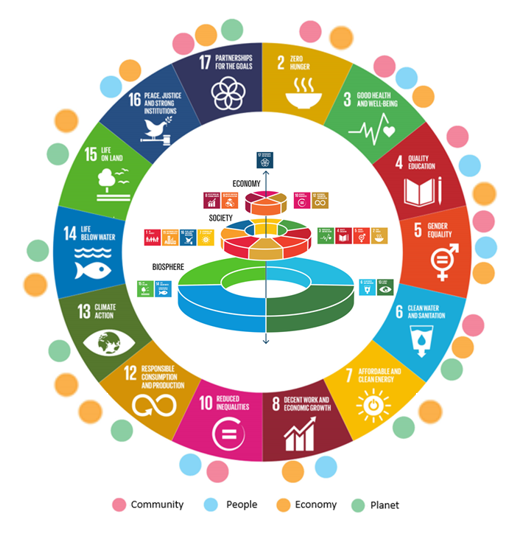
Comprehensive Planning, Special Resource / Area / Functional Plans, and Projects
The CNMI CSDP incorporates by reference the most current approved Community, Special Area, and Functional Plans as well as relevant development standards and their implementing policies and regulations. These planning efforts inform and are executed by targeted capital improvements and action plans that result in projects, capacity building, and other efforts to address identified needs, gaps, and opportunities throughout these iterative and interconnected efforts.
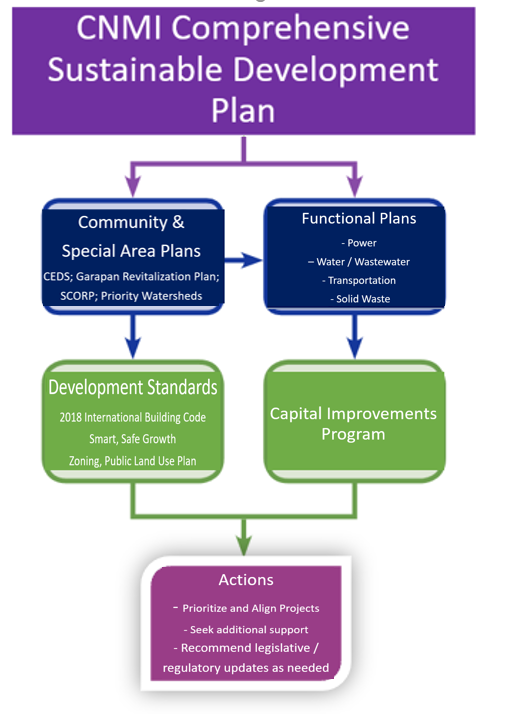
The policy elements outlined below reflect the “Crosswalk” of sustainable development planning areas. These efforts are supported by the “Special Area” and “Community Plans” which are typically geographically or issue focused, as well as “Functional Plans” that address resource management needs. Development standards are often project-specific but further inform best practices to support sustainability outcomes.
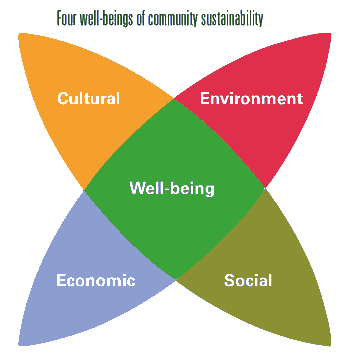
- Socio-economic development: Investing in critical lifelines and human resources
- Workforce and consumption patterns: Improving sustainability, supply chain resilience, and economic diversification
- Environmental Stewardship: Maintaining and enhancing environmental and cultural resources
- Partnerships: Expanding planning to support partnerships across sectors to support community well-being
Resource, area, and agency-specific planning efforts support achievement of the visions, goals, and objectives detailed in the Comprehensive Sustainable Development Plan. The most current approved version of the plans listed below is incorporated by reference and OPD will work with the PDAC and planning partners to continue to support timely updates.
Special Area/Community Plans
- CEDS
- CHCC – Strategic Plan
- COTA & DPW – Transportation Improvement Plan
- CPA Harbor and Airport Plans
- DCRM – SLUMP, Mooring Buoys Management
- DLNR-DFW – SWAP, Marina Management
- DLNR-Forestry – Wildland Fire Plan; Statewide Assessment and Resource Strategy
- DFW/DoD – Integrated Natural Resources Management Plan for Range Operations Areas
- HPO/DoD – Integrated Culture Resources Management Plan for Range Operations Areas (update pending publication)
- HSEM / HMGP – Hazard Mitigation Plan
- Catastrophic Typhoon Plan
- Tsunami Evacuation Plan
- Hazard Map Revisions for FY20 Update
- MVA – Tourism Sustainability Plan
- NMHC – Strategic Plan, Disaster Action Plan
- NPS – American Memorial Park Management Plan
- Priority Watersheds:
- Achugao (publication pending)
- West Garapan
- Laolao
- Talakhaya, Rota
- SCORP
- Garapan Revitalization
- Functional Plans
- CUC – Power, Water, Wastewater Plans
- DPL – Public Land Use Plan
- DPW – Highways Management Plan, Solid Waste Management, Nonpoint source pollution and stormwater management plan
- Wetlands Advisory Council – Comprehensive Wetlands Management Plan
- Development Guidelines & Standards
- Saipan Zoning Regulations
- Bureau of Environmental and Coastal Quality Development Regulations – BECQ-DEQ One Start; BECQ-DCRM APC/Major Siting
- Commonwealth Utilities Corporation – Power, Water, Wastewater connections
- Department of Natural Resources – Fish & Wildlife, Forestry, Invasives & Quarantine
- Department of Public Works – Building Code Division (IBC 2018)
- Department of Public Works – Floodplains Management
- Historic Preservation Office – Historic Preservation Plan (Public Laws 3-39, 10-71, and Administrative Code 55-10)
- Smart, Safe Growth
- Prioritizing Actions with SSG
- Endorsed for application by PDAC, OMB-SA/GAR, SMHO +
- Supports scoping and coordinated project development for resiliency outcomes
- Matrix update and development standard implementation training / BMPs underway with support from FEMA/EPA
- Planning Next Steps and Policy Recommendations
- Continue development, adoption, alignment, and implementation of resource- and sector-specific planning updates – See Planning Update Schedule in Appendix # (pending)
- Support information sharing and iterative planning including leading the development of community plans at the precinct level for inclusion in the 2025 CSDP Update
- Enable financial transparency and accountability through online information sharing and involvement of stakeholders early in planning and project scoping
- Next steps: Work towards 3-5 year goals, continued data collection, integration of existing and new plans with these guiding principles, visions, goals, and objectives.
Planning Elements and Policy Recommendations
